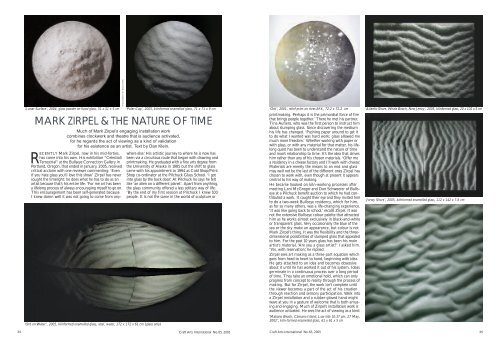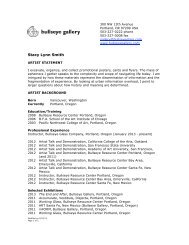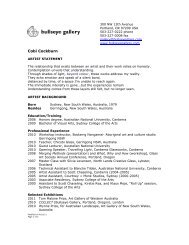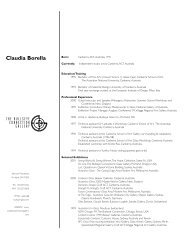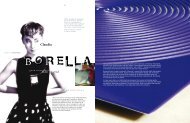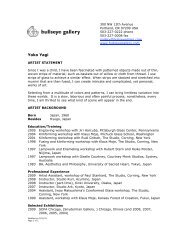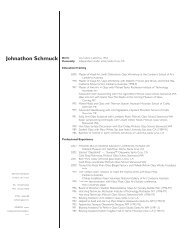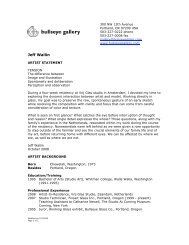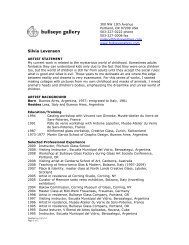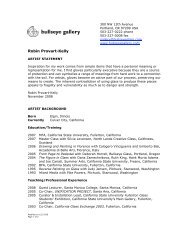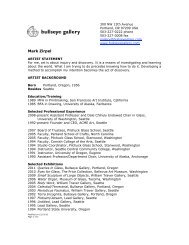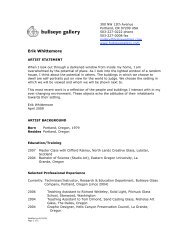Mark Zirpel December 1, 2005 - Bullseye Gallery
Mark Zirpel December 1, 2005 - Bullseye Gallery
Mark Zirpel December 1, 2005 - Bullseye Gallery
You also want an ePaper? Increase the reach of your titles
YUMPU automatically turns print PDFs into web optimized ePapers that Google loves.
‘Lunar Surface’, 2004, glass powder on fused glass, 51 x 51 x 5 cm<br />
MARK ZIRPEL & THE NATURE OF TIME<br />
Much of <strong>Mark</strong> <strong>Zirpel</strong>’s engaging installation work<br />
combines clockwork and theatre that is audience activated,<br />
for he regards the act of viewing as a kind of validation<br />
for his existence as an artist. Text by Dan Klein.<br />
‘Orb on Water’, <strong>2005</strong>, kilnformed enamelled glass, steel, water, 172 x 172 x 61 cm (glass only)<br />
PHOTOGRAPHY BY MARK ZIRPEL<br />
‘Polar Cap’, <strong>2005</strong>, kilnformed enamelled glass, 71 x 71 x 9 cm<br />
RECENTLY <strong>Mark</strong> <strong>Zirpel</strong>, now in his mid-forties,<br />
has come into his own. His exhibition “Celestial/<br />
Terrestrial” at the <strong>Bullseye</strong> Connection <strong>Gallery</strong> in<br />
Portland, Oregon, that ended in January, <strong>2005</strong>, received<br />
critical acclaim with one reviewer commenting: ‘Even<br />
if you hate glass you’ll love this show.’ <strong>Zirpel</strong> has never<br />
sought the limelight; he does what he has to do as an<br />
artist because that’s his entire life. ‘For me art has been<br />
a lifelong process of always encouraging myself to go on.<br />
This encouragement has been self-generated because<br />
I knew damn well it was not going to come from anywhere<br />
else.’ His artistic journey to where he is now has<br />
been via a circuitous route that began with drawing and<br />
printmaking. He graduated with a fine arts degree from<br />
the University of Alaska in 1985 but the shift to glass<br />
came with his appointment in 1994 as Cold Shop/Print<br />
Shop co-ordinator at the Pilchuck Glass School. ‘I got<br />
into glass by the back door.’ At Pilchuck he says he felt<br />
like ‘an alien on a different planet’. Apart from anything,<br />
the glass community offered a less solitary way of life.<br />
‘By the end of my first session at Pilchuck I knew 100<br />
people. It is not the same in the world of sculpture or<br />
‘Orb’, 2001, relief print on rives BFK, 72.2 x 72.2 cm<br />
printmaking. Perhaps it is the primordial force of fire<br />
that brings people together.’ There he met his partner,<br />
Tina Aufiero, who was the first person to instruct him<br />
about slumping glass. Since discovering the medium<br />
his life has changed. ‘Pushing paper around to get it<br />
to do what I wanted was hard work; glass allowed me<br />
much more freedom.’ Whether working with paper or<br />
with glass, or with any material for that matter, his lifelong<br />
quest has been to understand the nature of time<br />
and man’s relationship to time. It’s the idea that drives<br />
him rather than any of his chosen materials. ‘Offer me<br />
a residency in a cheese factory and I’ll work with cheese.’<br />
Materials are merely the means to an end and glass<br />
may well not be the last of the different ones <strong>Zirpel</strong> has<br />
chosen to work with, even though at present it appears<br />
central to his way of making.<br />
He became hooked on kiln-working processes after<br />
meeting Lani McGregor and Dan Schwoerer of <strong>Bullseye</strong><br />
at a Pilchuck benefit auction to which he had contributed<br />
a work. It caught their eye and they invited him<br />
to do a two-week <strong>Bullseye</strong> residency, which for him,<br />
as for so many others, was a life-changing experience.<br />
‘It was like going back to school,’ recalls <strong>Zirpel</strong>. It was<br />
not the extensive <strong>Bullseye</strong> colour palette that attracted<br />
him as he works almost exclusively in black-and-white<br />
or transparent glass. Very occasionally the blue of the<br />
sea or the sky make an appearance, but colour is not<br />
<strong>Mark</strong> <strong>Zirpel</strong>’s thing. It was the flexibility and the threedimensional<br />
possibilities of slumped glass that appealed<br />
to him. For the past 10 years glass has been his main<br />
artist’s material. ‘Are you a glass artist’ I asked him.<br />
‘Yes, with reservation,’ he replied.<br />
<strong>Zirpel</strong> sees art making as a three-part equation which<br />
goes from head to heart to hand, beginning with idea.<br />
He gets attached to an idea and becomes obsessive<br />
about it until he has worked it out of his system. Ideas<br />
germinate in a continuous process over a long period<br />
of time. They take an emotional hold, which can only<br />
progress from concept to reality through the process of<br />
making. But for <strong>Zirpel</strong>, the work isn’t complete until<br />
the viewerbecomesapartoftheactofhiscreation<br />
through reaction and sensory participation. Walk into<br />
a <strong>Zirpel</strong> installation and a rubber-gloved hand might<br />
wave at you in a gesture of welcome that is both amusing<br />
and engaging. Much of <strong>Zirpel</strong>’s installation work is<br />
audience activated. He sees the act of viewing as a kind<br />
‘Mabano Beach, Camano Island, Low tide 10:37 pm, 27 May,<br />
2002’, kiln-formed enamelled glass, 61 x 61 x 5 cm<br />
‘Atlantic Shore, Whale Beach, New Jersey’, <strong>2005</strong>, kilnformed glass, 20 x 102 x 5 cm<br />
‘Jersey Shore’, <strong>2005</strong>, kilnformed enamelled glass, 112 x 142 x 7.6 cm<br />
34 Craft Arts International No.65, <strong>2005</strong><br />
Craft Arts International No.65, <strong>2005</strong> 35
The ‘Body Work’ exhibition at William Travers <strong>Gallery</strong>, Seattle, Washington, <strong>2005</strong>.<br />
Pieces shown: ‘Beggar’, activated prosthetic arm, voice chip with speaker and motion<br />
sensor, 157 x 58 x 48 cm; ‘Broken Eye Chart’, kiln-formed glass, enamel, 81 x 51<br />
x 1.3 cm; ‘Viewer Activated Greeting Device’, blown glass, latex, air pump, motion<br />
sensor, inflated size 40.6 x 12.7 x 7.6 cm<br />
‘Tide Machine’, 1998, Borosilicate glass, water, motor, string, lead, lens, lithograph,<br />
xerox, pulleys and wood, 213 x 122 x 35.5 cm<br />
‘(Beggar) A socio-economic inquiry into the practice of begging’,<br />
<strong>2005</strong>, pneumatically activated prosthetic arm with tin can, voice<br />
chip with speaker and motion sensor, 157 x 58 x 48 cm<br />
of validation for his existence as an artist.<br />
<strong>Zirpel</strong> enjoys exploring the technology and machinery<br />
which enable ideas to assume a concrete presence in<br />
the world. The technical paraphernalia of both printmaking<br />
and glassmaking are an endless source of fascination<br />
for him. ‘I don’t have any facilities other than<br />
a glass cutter,’ he says, although his studio still contains<br />
machinery used as a printer and includes an etching<br />
press, a litho press, a darkroom and welders. Gradually,<br />
as and when he can afford it, glassmaking equipment<br />
is also finding its way there and he is planning to build<br />
his own kiln. He is like a kid with toys when exposed<br />
to new equipment. For him the joy of making is closely<br />
linked to inventive technology. He embraces the challenge<br />
of unfamiliar machinery and likes to experiment<br />
with new ways of using technology to translate ideas<br />
into reality. He could never be accused of being set in<br />
his ways. ‘Discovery is part of what I do.’ In another<br />
life <strong>Zirpel</strong> thinks he might have chosen to be a material<br />
scientist.<br />
Until now his life as a glass artist has been spent going<br />
from one artist’s residency to the next, always working<br />
to further his ideas both during the residencies and<br />
during the periods in between. Over the past five years<br />
he has done 10 residencies and has enjoyed all of them.<br />
For <strong>Zirpel</strong> they have provided the ideal lifestyle, though<br />
this may not continue to be so. ‘During a residency I<br />
experiment 24 hours a day and see what happens.’ They<br />
have taken him all over the US and to the far north<br />
of Scotland. It was a 2004 residency at North Lands<br />
Creative Glass in Caithness where an endless sky and<br />
magical light inspired his Portland show “Celestial/<br />
Terrestrial”. For <strong>Zirpel</strong> the appeal of residencies lies<br />
partly in the fact that they offer the opportunity to work<br />
with equipment he doesn’t have access to in his studio.<br />
Residencies are also seen as a way of breaking with<br />
routine. <strong>Zirpel</strong> quotes Marcel Duchamp’s dictum “style<br />
is habit” and adds: ‘I don’t think habit is necessarily<br />
such a good thing. Our modern way of living impinges<br />
on my incentive to make art. Social pressures, my own<br />
proclivities, get in the way – if you move yourself it will<br />
‘Life Support’, <strong>2005</strong>, cast silicone rubber, gurney, surgical light,<br />
air, reed, accordion bellows air pump, motion sensor and motor,<br />
305 x 366 x 279 cm<br />
‘Smoking Lung’, <strong>2005</strong>, blown glass, latex, accordion bellow, motor, cigar, smoke, steel motor, voice chip with speaker, 96.5 x 84 x 66 cm<br />
36 Craft Arts International No.65, <strong>2005</strong><br />
Craft Arts International No.65, <strong>2005</strong><br />
37
‘Heart’, <strong>2005</strong>, blown glass, 35.6 x 25.4 x 23 cm<br />
be a completely different experience.’ At residencies he<br />
has the feeling that he is ‘leaving the world behind’. ‘If<br />
you go to a residency merely to continue what you do<br />
in your own studio, there’s no point to it.’ He is always<br />
willing to try something new and although there are<br />
recurring symbols in his work, in particular the ellipse<br />
and the circle, he moves quickly from one concept to<br />
the next.<br />
<strong>Zirpel</strong>’s way of life is largely determined by this quest<br />
for discovery and creation and not by their accompanying<br />
financial rewards. He does not really make work<br />
with the express intention of selling, even though he is<br />
delighted when and if it does sell and is obviously enjoying<br />
his newfound success. He makes because he has to<br />
make and doesn’t mind confessing that ‘80 per cent of<br />
what I make is garbage’. There’s great artistic integrity<br />
in this degree of risk taking. If he has to make money<br />
in order to live, <strong>Zirpel</strong> thinks nothing of taking on con-<br />
‘White Luna/Black Luna’, 2003, kiln-formed glass, enamel and<br />
salt, each glass piece 20 x 91 x 7.6 cm<br />
struction work to supplement his income. His landlord<br />
in Seattle is a property developer and <strong>Zirpel</strong> worked for<br />
him as and when he has had to. Until recently he did<br />
not have a gallery, but that has changed with two major<br />
shows: one at Bill Travers <strong>Gallery</strong> in Seattle, the other<br />
at <strong>Bullseye</strong> in Portland. As <strong>Zirpel</strong> gets noticed and discovered<br />
there will be more solo shows.<br />
<strong>Zirpel</strong> is part Dr Caligari and part poet: occasionally<br />
both sides of his personality find expression in the same<br />
work. Of late, however, poetry has taken precedence<br />
over funk. In both modes he addresses the same concerns,<br />
looking at various aspects of nature and relating<br />
them to time. Viewing a <strong>Zirpel</strong> installation is a new way<br />
of experiencing time. The passing of time for him is<br />
not so much regulated by the tick of a wristwatch as by<br />
the ways in which it affects everything in the universe.<br />
The phases of the moon and their effect on nature; the<br />
searing heat of the sun and its effect on the parched<br />
earth; the marks left by the tide on sand; and the beating<br />
of the human heart, are the subject matter of his<br />
work. With every ebb of the tide different impressions<br />
are left on the sand. And <strong>Zirpel</strong> has recorded nature’s<br />
sand impressions by taking moulds of them. In a process<br />
of his own invention he translates nature’s patterning<br />
into glass. His plaster moulds taken from sand patterns<br />
left by the tide can weigh up to 363 kg (800 lbs). Part<br />
of the process of discovery was finding a method of<br />
cutting them up (the largest became a six-part mould)<br />
and transporting them to his studio. The rim of light<br />
around the darkness of an eclipse is another favourite<br />
visual phenomenon that he likes to re-create in black<br />
glass with a halo of white enamel light.<br />
The installations that <strong>Zirpel</strong> creates combine clockwork<br />
‘Leaf’, 2003, sandblasted enamelled glass,71 x 14 x 0.6 cm<br />
and theatre. Blown and kiln-formed glass combine<br />
playfully with found objects, ranging from bagpipe reeds<br />
to rubber tubes. Different elements are joined together<br />
and simple mechanical devices make them move or<br />
vibrate. Together they create a contemplative environment<br />
that makes one think and smile. One of his installations<br />
incorporates a device which measures how long<br />
you have spent viewing it. <strong>Zirpel</strong> was intrigued by a<br />
statistic that claimed that the average time spent viewing<br />
a work of art was seven seconds. Another work has<br />
‘a viewer-activated greeting device’. Yet another, entitled<br />
Swimulator, was conceived for an audience of dogs. The<br />
overall effect is of a half-joking, half-serious chemistry<br />
lab with stage lighting. In some installations glass components<br />
that take their inspiration from human body<br />
parts (the digestive tract, the heart, and genitalia) are<br />
linked to mechanical devices, cog wheels, levers and<br />
motorised parts that appear to monitor their functions,<br />
making us aware through metaphorical reference of the<br />
way in which time affects everything in and around us.<br />
The death of his father caused him to think long and<br />
hard about the ageing process in human beings. The<br />
installations are dimly lit overall with bright pools of<br />
light here and there. Light is as important as shadow in<br />
<strong>Zirpel</strong>’s work. Sometimes installations are accompanied<br />
by sound devices, not conventional music but sound<br />
patterns created by devices such as the random plucking<br />
of piano strings, reminiscent of the music of John<br />
Cage and the fluxus movement of the 1960s.<br />
Within these installations are a series of poetic wall<br />
pieces, usually composed of kiln-formed, enamelled and<br />
sandblasted black or white glass, which have a fragile<br />
and lyrical quality. Some possess elliptical or circular<br />
impressions, occasionally with the ellipse and the circle<br />
juxtaposed; sometimes the<br />
ripple of sand is re-created.<br />
Textures are smooth and matt<br />
or rough and gritty, resembling<br />
a moonscape. <strong>Zirpel</strong> has<br />
also devised an ingenious way<br />
of transferring photography<br />
onto special film which, when<br />
laid on the glass surface, can<br />
be sandblasted to produce a<br />
unique kind of imagery. With<br />
this technique he has created<br />
<strong>Mark</strong> <strong>Zirpel</strong>, <strong>2005</strong><br />
skeletal images on glass of<br />
leaves found on forest walks.<br />
Deprived of light they have lost everything except the<br />
detailed veining which once nourished their greenery.<br />
When transferred onto glass the metamorphosis is magical.<br />
In translation the dead leaf has taken on new life,<br />
been resurrected as it were; through sandblasting the<br />
veining shines with a sparkling light.<br />
<strong>Mark</strong> <strong>Zirpel</strong> sees what he does as a way of life and not<br />
as a career path. He doesn’t want the market to determine<br />
the kind of work he makes, though he sees market<br />
approval as validation of ‘this undefined thing that one<br />
does’. This gives him the courage to make art for its<br />
own sake in an increasingly competitive world. He is<br />
uncompromising and certainly never driven by gallery<br />
expectations. If a gallery likes his work he will exhibit<br />
there, often aware that his type of installation may have<br />
little commercial appeal. A few enterprising galleries<br />
have thought the risk worth taking. It makes a welcome<br />
change in a marketplace governed by collectors and<br />
gallery owners with a growing tendency to judge success<br />
rates by sales figures.<br />
Dan Klein<br />
For further information contact the artist at 315 North, 36th Street,<br />
Seattle, WA 98103, US. Email: kramlepriz@yahoo.com<br />
‘Projector/microscope’, 2003, kiln-formed oil lens, bullseye glass, kerosene, fire, lead,<br />
copper and stainless steel, 81 x 51 x 122 cm<br />
‘Terrestrial/Celestial’, <strong>2005</strong>, fused, fumed, sandblasted glass, 102 x 76 x 0.6 cm<br />
38 Craft Arts International No.65, <strong>2005</strong><br />
Craft Arts International No.65, <strong>2005</strong><br />
39


